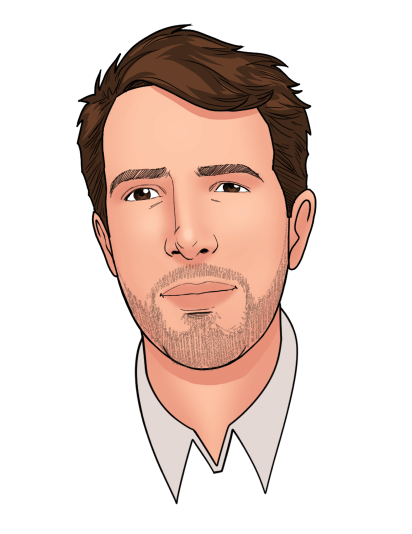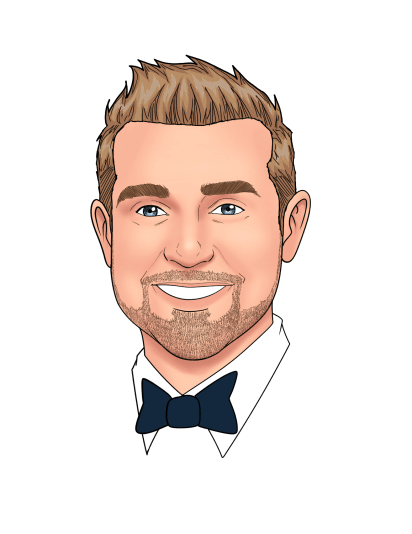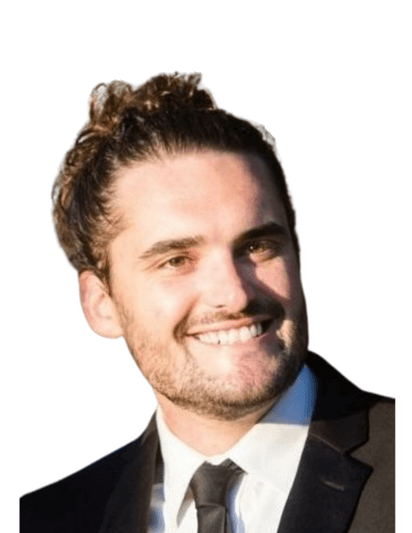
106
Episode 106 46 mins
Running Remote Teams: Applying the Hierarchy of Communication to Even the Remote Playing Field
Liam Martin, Co-Founder of Time Doctor & Running Remote
00:00
00:00

"I have what I call the rule of three, which is the first time that I do something, I don't document it. The second time that I do something, I think about how I'm going to document it. And then the third time, I absolutely do document it. And the reason why it's the third time and not the 100th time is you lose some of the details inside of that documentation."
In this episode
Distance bias can play a huge role in hybrid offices.
So, what is the cheat code to hybrid? All management should be fully remote.
Liam Martin is the Co-Founder of Time Doctor and the world’s largest remote conference, Running Remote.
In episode #106, Liam shares his thoughts on hybrid work and the impact of distance bias.
Liam also explains his rule of 3 during the documentation process and his hierarchy of communication.
Tune in to hear all about Liam’s leadership journey and the lessons learned along the way!
Like this episode? Be sure to leave a ⭐️⭐️⭐️⭐️⭐️ review and share the podcast with your colleagues.
04:07
Early delegating mistakes
09:31
Can hybrid work be successful?
17:20
How to master asynchronous work
23:19
The rule of three
26:31
Managing chat tools
33:23
Hiring for remote
39:00
The communication hierarchy
Resources
- Learn more about Liam’s book Running Remote
- Check out the conference Running Remore
- Follow Liam here
- Listen to Scott Williamson’s Supermanagers episode
Transcript
Aydin Mirzaee (Fellow.app) 00:36
Liam, welcome to the show.
Liam Martin (Time Doctor) 03:03
Thanks for having me, Aydin, I am so excited to be here. I gotta tell you, this is my 390/3 podcast that I’ve done on my podcast run. And this is the one that I am most excited about. Because I’ve been so preparing for this podcast, I read all of your notes. By the way, for people that don’t know, Aydin writes like, Oh, now you’re spoiling it for people who have notes in preparation. I thought it was so cool that you wrote all these notes. So I’m excited to get into the nitty gritty with you.
Aydin Mirzaee (Fellow.app) 03:33
See, nobody knew that we have prepared notes in advance. You ruined it, people thought I was so good at coming up with questions on the fly. And now everybody knows your secrets out. Yeah. But Liam, you are obviously super popular. You’re kind of the thought leader, in my opinion on remote work. And so it’s very exciting. I’m not surprised that you’ve done almost 400 podcasts, we’re obviously going to be talking about very unique things that nobody else has ever heard of. So what you’ll say on this podcast is going to be very well received. But you know, just on your background, obviously, you were doing remote before remote was cool. You’ve been working remote for over 15 years, co founder of Time Doctor, like when I think about companies like really leading the way in the remote space. Obviously Time Doctor is at the top of the list. But what we wanted to start to talk to you about was this concept of like when you first started managing and leading teams. So do you remember when that was and what were some of the very early mistakes that you made? So I’m
Liam Martin (Time Doctor) 04:38
not a very good manager. Definitely not designed to manage hundreds or 1000s of people I think I’m probably best managing. I would say Max like six people outside of that. It really becomes a chore for me. And number one, you’re always so great at pumping up my ego because you always compliment me and do these fantastic things. By I don’t like the term thought leader, because I think instead of thought leader, it’s not someone who actually does things inside of their own businesses and is like an operator. So I think of the same thing with regards to management, I believe that you actually have to do some of the work that you’re delegating in order to actually be respected by your direct reports, which is why for me, I’m not really good at managing large swaths of people, because I feel very self conscious about delegating all these responsibilities and keeping none for myself, which does actually lead into a completely separate set of problems that I have. But inside of that the team members at least know like, I’m not going to tell them to do something that I wouldn’t otherwise have them do. But back first days of management, I mean, you know, that goes back to like 2006 2007, which was when I started my first online tutoring company. So right out of grad school, I ended up teaching a class at McGill University for grad school. And for those of you that don’t know, graduate students usually teach the first and second year classes, so you don’t actually talk to professors yet. And did this class started with 300 students ended up with less than 200 got the worst academic reviews in the history of the McGill, sociology department, which have been up and running for about 132 years. And I walked into my supervisors office, and I said, I don’t think I’m very good at this. And he said, No, you are not. And then I said, Okay, so what do you think I should do? He said, Well, you gotta get pretty good at this teaching thing for the next 10 to 20 years before you want to do anything fun. So six weeks later, I threw a master’s thesis under his door, and I was out into the real world. And that started my very first business, which was an online tutoring company. And I was working through like old school, Skype tutoring students, and I had dozens of tutors throughout North America, and Europe. And the management issue, actually, that I faced there, let into the next product Time Doctor, because I couldn’t account for the amount of hours that a tutor was working with a student. So a tutor would bill me for 10 hours as an example. And then the student would say, I didn’t work with my tutor for 10 hours and work with them for five, go back to the tutor and say, do work for 10 or five and say, I billed you for 10. So it ended up having to refund the student five hours and pay the tutor the full 10 hours, which meant I lost a whole bunch of money on the deal. And this was really destroying the business. And then my now co founder, Rob Rawson had a really crappy alpha of this tool called Time Doctor that could completely solve that problem, which was time tracking for remote teams, so that you could equate for how long someone worked for someone else when they were working for you remotely. So that’s kind of my first iteration of management. But there were many more disasters that came about in the next 10 years.
Aydin Mirzaee (Fellow.app) 07:43
Yeah, I mean, that makes a lot of sense. So it’s interesting, because I know I mean, you say you don’t manage large swaths of people. And and I know you’re very, very particular about like, really mastering the craft, you’re also not only my go to person for anything on remote work, but also things on marketing. So I think you do manage a pretty large operations. So I will say that maybe you don’t like having a lot of direct reports. But obviously, like, you know, I think you have a pretty sizable organization at Time Doctor. So why don’t we do this? I know, I mean, you’re talking about the remote concept. I mean, you’ve been remote for a very long time. You’re also the organizer of running remote, which is like the de facto remote conference in the world. And you’re also coming out with a book, I don’t know, if you’re able to share the title of the book that’s coming out.
Liam Martin (Time Doctor) 08:35
It’s called running remote. It has the same name. And we actually wanted to call the book async, a mutual friend of ours. Now, Kim Scott, I pitched that who wrote a fantastic book called Radical candor, I was pitching her async as a title. And she said, Why didn’t you use async? That’s so much better. But the reality is that when you work through a classical publisher working through HarperCollins, they’re really just looking at what’s the viability of this book for the large population, not just your 1000 true fans that are incredibly passionate about what you produce, because they’re effectively saying they’re gonna buy the book no matter what. And you need to be able to approach a much larger group. So the book is actually called running remote as well. So if you just Google running remote, you find the book and you’ll find the website.
Aydin Mirzaee (Fellow.app) 09:23
Yeah, no, that’s awesome. And so let’s talk about, you know, some of the things, I guess, like, if we’re going to go down to it, I think what’s super topical right now, is that there are all of these companies that you know, were forcibly remote when the pandemic happened, and now they’re going back to the office or they’re adopting this notion of hybrid work. What are your thoughts on hybrid work? Like, do you think this is the wave of the future?
Liam Martin (Time Doctor) 09:49
No, it’s not going to work. It’s going to be a huge disaster for everybody.
Aydin Mirzaee (Fellow.app) 09:52
huge disaster for everyone. Like all of the large companies with 10s of 1000s of employees.
Liam Martin (Time Doctor) 09:59
They don’t know what they’re Talking about, it’s a huge disaster, it will result in probably the, I would probably say the biggest problem since our transition to remote work. In 2020, February of 20 24% of the US workforce was working remotely. by Marx, that was 45% of the US workforce, we’re now sitting at about 33%, with 5% of the population, the United States, stating that they’re working from home due to COVID, 60% of the people that are remaining in part remote, which is about 77% of those people are going with hybrid, as opposed to in person or remote, the fully remotes about 30% 10% are going back to the office completely. This creates a huge problem. I mean, the biggest singular problem is, you get none of the advantages of remote work. But you still have all the disadvantages of the office environment. And it is exasperated by what I call distance bias. So whenever you have a manager, and I think this is really interesting, by the way, for a tool like fellow because I use it almost every day, and it’s a great way to be able to create a barrier towards distance bias. If I’m in a meeting with eight people, and three of them are remote, and five of them are in the office, we’re all going to agree on something, we’re going to open up our fellow, we’re going to go through all of our tasks, and we’re going to discuss our issues. And we’re gonna say, here are the action points that we have, we’re going to proceed with planning. And those three people are going to pop off of zoom. And then I’m going to turn to you Aydin. And I’m going to say, Susan doesn’t know what the hell she’s talking about. She’s an idiot, listen, you don’t want to go with a you want to go with B. And these undocumented conversations are going to bias the manager because the manager just by extension, is going to adopt ideas of people that are closer to them. And it’s not necessarily the managers fault. They can try to manage this process. But a lot of the early research that’s coming out is showing that they can’t. And that remote worker that wakes up the next morning, and says I thought we were doing a and now we’re doing b feels completely disenfranchised. And they feel like a second class worker inside of the organization. So they either have to move into the office in order to be able to work closer with Aidan, or they have to say to themselves, listen, I’m tired of this company, I’m gonna go work for someone else that can actually allow me to be able to work remotely.
Aydin Mirzaee (Fellow.app) 12:30
Yeah, so this notion of distance bias, like this is a I mean, this is something that I remember in my previous life, while I was working at Survey Monkey, I mean, we had multiple offices. And so we definitely felt that when we were working, we were kind of like the satellite office in Ottawa, and we were working with to the San Francisco office. And we had that that sort of feeling of, you know, it’s very hard to be there fully, or get the same experience. So, I mean, is there any solution to this, like, if people are very adamant, like, if you have a company that, you know, some people will truly want to be remote, and other people, they don’t have the right working environment, they just like getting out of the house, or whatever it may be. And they do want to go to a physical working environment, like what is the solution.
Liam Martin (Time Doctor) 13:18
So the cheat code for me is really the focus of the book, which I’m calling asynchronous management. So the ability to be able to manage people without directly interacting with them, and allowing them to communicate and collaborate when it’s most advantageous for them, as opposed to when the manager or the decision maker wants to be able to collaborate. So this kind of deletes all of these problems, because all of a sudden, you move from these undocumented conversations that are happening in the boardroom, to everyone meeting on the same turf. Right. So and just this is the proposal for a hybrid work, but I don’t exactly know how we’re going to navigate through it, which is alright, so whether you’re in the office, or you’re not in the office, everyone’s just got to do a zoom call in front of their own computers. That seems so stupid, right? Like, you’re gonna have five people that are in the same office that are not going to go into the boardroom, but they’re actually going to sit at their own computers, and they’re going to have the meeting where everyone is remote. It works on a small scale. For someone like me, I had an office that was very close to yours. At one point, we had a couple people in that office, but I was really diligent about making sure that if we were having meetings and people in that office, were in the same meeting, and we had remote team members, that we didn’t actually all meet on one zoom call, but we needed separately. But pragmatically, it’s a really tough mountain to climb, and I just don’t see that happening practically. So I have a lot of concern about where remote work at well, we’re more specifically where hybrid work is going to go. I would actually suggest to people that they go back to the office. I think that that’s probably a better place to start. And I think actually Is 36 months from now that 60% That’s going hybrid, it will melt off into remote and office. So I think that that’s inevitably what’s going to happen, I think probably within 36 months, hybrid will be not the number one choice will definitely be the second most popular choice and possibly the third most popular choice inside of remote hybrid in an office.
Aydin Mirzaee (Fellow.app) 15:21
What do you think about like, I guess one of the things that I think is for people that if it’s strictly a concept of wanting to work in an office or basically not working in your bedroom, or on, you know, the kitchen counter, what about like, all the co working spaces, like, is there a case for a we work, come back with a vengeance, and, you know, people still working like if you if you wanted to leave your house, but still work remotely, that that’s something that you could do. So you’re not saying that you can’t go into an office, but you’re saying like, it’s not really mandatory for all of you to be in the same office,
Liam Martin (Time Doctor) 16:00
I think that there definitely is a huge opportunity for an AWS of office space. So a cloud account for office space, which is effectively what we were trying to do. We had a we work account where I think we had like 10 Floating seats. So you could have 10 individuals that would check in to a we work somewhere on planet Earth. And once you’re up to the 10th, subscription, and you couldn’t actually go into a we work anymore. And we just gave that to everyone inside of the organization. So remote work to me is like work from the office work from home work from a coffee shop, work from a co working space, work from the beach, don’t work from the beach, by the way, I tried it, once you get a lot of sand in your laptop, it cost you like 500 bucks to fix it. But outside of that work wherever you want. It’s really about actually getting the work done. It’s not about specifically where you work. But it’s really important for there to be an even playing field across all of your team members from a managerial perspective. And remote work provides that equal playing field hybrid, unfortunately, at this point does not and I think there’s a and or there’s a very serious mountain to climb to be able to get over that bias.
Aydin Mirzaee (Fellow.app) 17:18
Yeah, that makes a lot of sense. So I think like what you’re saying, and it seems like one of the main things that you discuss in the book is how did you asynchronous really well. So maybe walk me through a week in the life of you I know, right? Now you have the conference going on. And maybe a week in the life of of someone like yourself is a bit different. But you know, thinking when you’re not like busy with with the conference with running remote the conference or promoting running remote the book, right? What does it look like to work at? You know, largely one of my company? Yeah, is asynchronous, mainly.
Liam Martin (Time Doctor) 17:55
Yeah, so I was able to jump in for a couple days on Git labs organization. So I really wanted to learn more about and Git Lab is a is a leader. In asynchronous work, they are remote, but they really kind of think about as they think about asynchronous work is what’s more important than necessarily whether they’re remote or not. And it was funny because I started asking questions to people in the organization. And after asking, like a dozen questions, the guy that brought me in pinged me, and he’s like, Hey, dude, so you’re being super disruptive to everyone else’s workflow, like, you can look this up and our process documents, and it’s going to take you five minutes to find the answer, stop disrupting other people’s flow by asking questions, which I know is a probably a really weird way to be able to run a business. But that’s like, the core nucleus of what asynchronous work is all about. The underpinnings for asynchronous work, I believe is and you should have this guy in podcasts that you can get on Cal Newport, who wrote this book called Deep Work, which is effectively having everything at your disposal to be able to solve really hard problems. So unique and hard problems is the critical piece there. So everything that is not unique, you should build into process documentation. So GitLab, as an example, has the largest process document, open source process document on the planet, it’s about duck gitlab.com/handbook. And they have like 8000 entries. Everything about GitLab is in there. And you can just access it, and you can steal their processes and you can repurpose it for yourself. So my workday is like, I’ll go in. I usually know the vast majority of the processes that I have throughout, you know, that I need to do throughout my workday, but anything that is something that’s replicable, I do to process and then I try to optimize as much of my day towards deep work. So what are the innovative issues that I need to be able to tackle In order to be able to move the business forward, because I actually think at the end of the day, when you think about any company, any corporation, if you can innovate faster than your competitors, you end up winning, right. So like, if you just optimize your entire workforce towards deep work, then you’re going to be a lot more effective. Overall, it doesn’t really matter what you’re doing, you’re just going to be able to solve difficult problems faster. And the majority of people that do not equate to asynchronous management, they do a lot of things throughout their workday that they could literally Automate, you know that, like, we have a document that we have everyone write the first three months that they joined the company, which is how to do my job, which pulls all of the sacred knowledge they might have inside of the organization out and moves them from owning a particular position to currently operating that position. So I do not, I am not the CMO of the company, I currently operate the position of CMO of the company. And at any point, if I need to delegate the responsibility of CMO, the company I can if a more difficult problem comes along, like writing this book for the last year and a half and really focusing my energy on that. And having a guidebook to help more people’s mission on empowering the world to transition towards remote work. So like that’s the piece that is really important is just getting a lot of the bureaucracy of work off of your hands. I mean, the end of the day fellow actually really does this super well, because you literally just took all of the secret notebooks that people have in their hands, where they’re like, hey, you know, I really got a problem with Aydin, like, he is an idiot. And I’m writing this down in my notebook, and he doesn’t know what he’s talking about, at least we’re kind of able to document that in one singular place. And it just removes that extra collaborative step that people would usually take when sitting down to a meeting, everyone actually knows what the heck they’re talking about before they actually sit down for that meeting. That’s a small piece of what I’m talking about when I’m when I’m talking about asynchronous work. But it’s just that at scale, everyone knows everything inside of the organization. There’s no closed doors, we have a policy of radical transparency inside of the organization where everyone knows everything else. And ideally, everyone should have the same informational advantage as the CEO of the company.
Aydin Mirzaee (Fellow.app) 22:20
Okay, they’re just a quick note, before we move on to the next part, if you’re listening to this podcast, you’re probably already doing one on one meetings. But here’s the thing, we all know that one on one meetings are the most powerful, but at the same time, the most misunderstood concept in practice and management. That’s why we’ve spent over a year compiling the best information, the best expert it buys into this beautifully designed 90 Plus page ebook. Now, don’t worry, it’s not single spaced font, you know, lots of tax, there’s a lot of pictures. It’s nice, easily consumable information, we spent so much time building it. And the great news is that it’s completely free. So head on over to fellow dot app slash blog to download the Definitive Guide on one on ones. It’s there for you. We hope you enjoy it. And let us know what you think. And with that said, let’s go back to the interview. Yeah, I mean, this is super interesting, just the I love this idea of everyone writes how to do my job. And they kind of document that that’s super clever. And like a really great way to encourage documentation. We’ve had, I guess, you know, Darren, Murph, Scott Williams, and also from get lab on the show. And also europeu, runs remote.com, who you introduced me to actually, he had this like, motto that he told us about, which is like respond with a link. And that’s kind of like a cultural thing that they do you have a saying about like when you should actually start to create documentation for something right, like, so how do people think about that? So that’s a really good tactical thing. When you started a job, write a document on how to do my job, because you’re operating in that position? What other things would you recommend people do or organizations do to create more institutional knowledge and documentation?
Liam Martin (Time Doctor) 24:19
Well, first off, you really need to figure out what you should turn into process documentation and what you shouldn’t. There’s a great book called E Myth. If you haven’t read it yet. That’s a great starting point for all of this stuff. But effectively, I have what I call the rule of three, which is the first time that I do something, I don’t document it the second time that I do something, I think about how I’m going to document it. And then the third time, I absolutely do document it. And the reason why it’s the third time and not the 100th time is you lose some of the details inside of that documentation. If you do something the 100th time, like if you’re at the gym, Aydin and you’re prepping to do squats, right. I know that you squat a lot, and you’ve probably squatted 20,000 times in your weightlifting career, you probably have lost a lot of the small little details that you had on, you know, the third day that you started squatting, where it’s like, okay, how should I put my feet together? You know, how should I hold the bar? How should my body be? So you gain all of the small details, you build that process? And then you immediately send that process to the people that will be using it, you don’t ask them? Is this a good process? Because that’s one of the stupidest questions that you could possibly ask. Because everyone will say, Oh, yeah, that’s great. But they won’t actually give you any feedback. You’re looking for feedback. So I instead say, what are three things I can do to improve this process? And then you literally just iterate through that. So you change the process, you bring it back to those people, you ask, what are three more things I can do, you go through, you know, usually we end up going through that two or three times before I get to what I call perfect process. And then that becomes a gold process that’s added into our internal wiki, a really great tool to use is either you can use an open source wiki program, which is completely free. You can use something like Git lab, actually, for a lot of process documentation. Or another great tool is trainable, which has a lot of process documentation. And it’s kind of like built into a SaaS product so that you can get very clear outcomes for everything that you do in the company. Yeah, we’ve
Aydin Mirzaee (Fellow.app) 26:22
had Jonathan from triennial onboard to I would, I would second that awesome guy. Yeah. So this is really interesting. So we’re talking about documentation, you’ve got your rule of three. So I guess my question is, what do you think about you know, a lot of people say that, Oh, we do asynchronous communication. Because we use Slack, we have slack. And so we’re an asynchronous organization. Is that like, fully true? Or like, how do you think about because, yes, you could respond asynchronously on Slack. But one of my, I guess, like issues or pet peeves with this is the, you know, what are the protocols around when you should respond to certain messages, you know, how often you should do that. And also, it’s also very interrupt driven, right? Because like, just like, there’s the email vortex that can suck you in. And if you start checking email, you could be doing that for hours. It’s a similar thing, depending on how large your organization is, I mean, you can get very distracted. Also, in some of these chat tools, are there any kind of like rules of thumb that you would recommend?
Liam Martin (Time Doctor) 27:25
Yeah, I mean, biggest one, from an overarching perspective is slack can totally be synchronous, if it requires immediacy. So you really just have to say nothing in the company requires immediacy, we have a Slack channel that we call Red Alert, because we’re kind of internet nerds. And we’d like Star Trek. And when someone posts a message in the Red Alert chat, everyone gets a notification on their phone. So like their their phones ring, whether it’s three o’clock in the morning, or whatever, everyone gets wrong. And that maybe happens once a year, on average. And we’re talking like, oh, Russia’s hacking us, that’s something that you have to post in the Red Alert chat, because it requires immediacy. And this really comes from the leaders and managers of the organization. I mean, I know in your company, if you’re like, hey, I need an answer to this, now, people are gonna jump up and say, okay, yeah, I’m gonna get an answer, I’m gonna get an answer that they’re not going to say like, Aydin, do you really need an answer for this right now, no one’s going to actually tell you that. So you actually have to be the person that controls the flow of communication and makes it okay to not require immediacy, on what’s you know, on the communication of the organization, because you think that you’re speeding yourself up, and you actually are speeding yourself up, and you’re slowing down the organization, because you’re creating this disruptive environment where people can’t achieve deep work, they really can’t get into that focus state that they need to be able to solve difficult problems.
Aydin Mirzaee (Fellow.app) 28:50
So that’s interesting. So there’s almost like a cultural norm that needs to be established, which is that if you, for example, posts in Slack, there is no immediacy required here. And it’s very interesting, because one of the things that I know about Time Doctor is you have employees in 43 countries. I imagine there’s a lot of time zones across all those countries. And so how do you think about, you know, different posting, I know, for example, when you’re largely on the same timezone, you might do things like maybe not post a message on a weekend or like schedule something to be sent at a certain hour? What are some like practices that you do in terms of understanding or like calibrating yourself, when people are in different time zones? How does that work also, with with your meetings, to the extent that you like, how many synchronous meetings do you have and how to how does all that work? Yeah, so
Liam Martin (Time Doctor) 29:45
first off, going back to just the disruption component, we remove notifications from Slack. So in your, in our onboarding documents, we literally show you like delete shutdown notifications, so you just not getting them popping up across Is your screen. So I process slack like I process my email, I just sit down and go through it. Right. And there are there are other ways of getting in touch with me if you require immediacy, but the vast majority of the time, you don’t need an immediate answer to the problem. And pretty much everything that has a notification, I would shut off email slack messages, this is disruptive towards your focus. You know, even if we’re doing this podcast, if you’re constantly seeing email notifications, and slack notifications, your focus will be pulled into those opposite directions. We also have another policy, which is, if we are actually going to do zoom calls, there’s none of this. And I’m looking down at myself right now, because I’m actually looking at my phone. So like, everyone needs to actually look at the camera and interact, if you’re going to go synchronous. So if you’re gonna go synchronous, go as synchronous as humanly possible, so that you get as much granularity as you possibly can. And I can remember the second aspect of your question, we talked about the tactics. What was the other part of the question?
Aydin Mirzaee (Fellow.app) 31:06
Yeah, it was mostly around how do you how do you decide, you know, which one of your meetings or what things you need to be synchronous on? And what things you don’t need to be synchronous on? Like, how do you make those decisions.
Liam Martin (Time Doctor) 31:18
So inside of fellow, we implement a version of Eos. And we’ll post issues about an EOS is entrepreneur operating system. For anyone that wants to go check that out, there’s a ton of books on that subject, which you can check out. And we write down issues about what we need to address in my weekly executive meeting, there’s nine people in that meeting, including me, and we write down all of our issues, and then we start to comment on those issues. So we’ll have common threads that I think the biggest one I’ve ever seen is 97 comments deep on a particular issue. But if we’ve come to a conclusion with that particular comment, or we take the conclusion we put at the top of the ticket, and then we clear the ticket. And if we have less than three issues before the meeting starts, we don’t have the meeting, because it’s just it’s not valuable for us to be able to actually jump in and and get everyone together. The other interesting phenomena has popped up when we do this is almost all the issues that don’t get resolved have nothing to do about the bureaucracy of the business. It has to do about EQ issues it has to do about emotional intelligence issues. It’s like, yeah, you know, Aydin is not getting along with Liam, and the CEO and the CMO are having issues about this particular problem inside of the business. And we need to be able to hash it out. And sometimes actually, that’s not how it’s presented. So it seems like we’re talking about something else. But you really have to let go deep underneath that and say, hey, you know what, guys, you guys are both having some major issues. We need to discuss it right now. Because you guys need to work together. And those are the issues that we end up addressing, not Hey, turn is bad. What are seven more things that we can do with regards to sharing, you can forget that all asynchronously. It’s the the EQ issues that you can’t solve async.
Aydin Mirzaee (Fellow.app) 33:07
Yeah, that makes a lot of sense. So for most things, then you’re solving this asynchronously, but things that especially like human interaction challenges, or maybe some of your one on one meetings, you do those on a synchronous basis. One thing that we haven’t really talked about is, is hiring. So I’d love to get your take on, you know, what you do at Time Doctor, or what you’ve done and what you’ve seen across all the remote organizations that you’ve kind of taken a look at? What do they do differently from a hiring perspective? And is there a special profile of person that you want to hire that can function well in a fully remote organization? Or is that not something that you look at?
Liam Martin (Time Doctor) 33:51
Yes, we absolutely, look at that. There’s one very clear signal that we’ve gotten time and time again, which is introversion. So if you’re an introverted individual, you end up having a longer your retention is much higher inside of remote teams than it is in on premise teams. Our mutual friend that you know, my product manager, Justin, he’s an introverted individual. He lived about five blocks away from me for eight years, and I maybe saw him once a year. That’s so funny. He just doesn’t want to talk to me, right? He doesn’t want to interact with me. But he’s a really good product manager, and he’s fantastic at his job. And he just knows, I mean, and I’ve actually asked him this a couple times. It’s kind of an inside meme, like company meme that Justin hates me. There was this one time in which we were taking a flight somewhere. I think it was to Indonesia. So it was like Ottawa to Indonesia. And my assistant had booked tickets next to us, and then he decided into book like, move his seat, two rows back. Because he said you were going to be disruptive towards my workflow, which I thought was hilarious. And now I’m just kind of saying like, well, you, you hate me. So every time we sit down somewhere, like, Oh, do you want me to sit next to you like, I don’t know whether or not that’s cool with you. And yeah, I kind of bust his his balls on that one quite a bit. introversion meant it’s the best, I actually think that asynchronous remote teams are in conjunction going to produce the rise of the introverted leader. And I know that that’s not you, you are really good talking to large groups of people, you’re relatively charismatic, I don’t have that same type of skill set or not the same type of skill set that you have. But remote enables me to really be able to lead organizations without having that capability. I know, before you even like, you look into a boardroom. And those boardrooms, they’ve all got like big glass boxes. Now. I can tell you, whose idea is gonna get adopted, or who’s going to lead the conversation. And it’s usually the tallest male, white male in the group, and brownie points if the guy looks like Captain America, like that’s the guy who has his ideas adopted, most often. Is this guy, does this guy have the best ideas? No, absolutely not. He probably actually has the worst ideas. But he’s really charismatic. And he’s very, very good at convincing people of his ideas in the moment. But someone like me, I’m much better at convincing people through Asynchronous means through texts through instant messaging, those types of things, because I can lay out my, my arguments for things, and I can convince people that way, a lot more effectively than I can in person.
Aydin Mirzaee (Fellow.app) 36:49
You know, it’s interesting, when we had Scott Williamson from GitLab, on the show, one of the things, the terms, I’m not sure if I attribute this to him, but it’s certainly the first time I heard it being used in this context, he called himself a synthesizer, meaning that like, he likes to get a lot of information, you know, take his time, come up with a response. And then it’ll be a really good response. But it’s very hard to do that, when everyone’s watching you. It’s all live your, you know, getting the information in real time, and then processing it and coming up with something. And he’s really like, organize a lot of his communication around even for the synchronous meeting, he will require an agenda and like full details of what’s going to be discussed, you know, 24 hours in advance. So he has the chance to process and like learn that information, and then come in and be able to have like a very meaningful discussion around it.
Liam Martin (Time Doctor) 37:44
I don’t know if you’re a history buff, but I love looking at ancient Rome, and ancient Rome was the first instance of a standing army. And before that, you’d have warriors, but you wouldn’t necessarily have like an army, whose profession it was to be soldiers. And you remove the individual charismatic components as a warrior, but then, as a group, you can absolutely overtake any other force because of organization. And I think what you’re talking about with regards to Scott, I mean, he’s super organized, when he jumps into a meeting, he’s probably able to have that meeting, be on time, focused, much shorter than a regular meeting and get into much deeper issues than if you just kind of showed up and said, Hey, we’re just gonna kind of see what comes out the other end of this meeting, those are just wastes of time to be completely honest with you. tools, like fellow provide an excellent framework to be able to lock that type of stuff in. But I mean, to me, it doesn’t matter whether you’re using Trello or anything else, you need something in place to be able to make sure that there’s a clear agenda. And that all of those things that can be made asynchronous are before you jump into the call,
38:55
you know, that obviously, I would agree with with all of what you said there.
Aydin Mirzaee (Fellow.app) 38:59
So one other question I did want to ask you about is just the hierarchy of communication. So you have a framework around this. So not every message should be communicated in the same way in the same channel. And I’m curious if you could tell us a little bit about how this framework works. And like how you actually use it practically,
Liam Martin (Time Doctor) 39:19
in person is better than video video is better than Audio, Audio is better than instant messaging and instant messaging is better than email. As you move up the chain. You become more synchronous. As you move down the chain, you become more asynchronous. You need to be able to figure out what can you solve at various levels, have a synchronicity, and reserve as much of your precious time for what’s important at the top of that framework. So we do a team retreat every single year or a company retreat where everyone flies into one particular place. It’s a conference about the company and everyone smiles flies into that one little place before COVID The one that we were going to choose was Moon Buy, we’d like to go in to really kind of cool in different locations. And we sit down and we say, Okay, what happened last year and what’s going to happen next year, but the preparation for that meeting takes at least six weeks in terms of us prepping all that information, getting the documentation in place, you know, oh, we weren’t approaching enough of ICP one. Okay, well, can we actually get the reports on that? Let’s get our HubSpot reporting, let’s get our CRM, you know, our our marketing documentation in place, let’s put that all in one place, get everyone to consume that information beforehand. And also possibly comment on it, hopefully, so that we can get to the real nitty gritty of why we’re not approaching ICP one, I can actually tell you, because this is a live example of what we had, I won’t tell you who that type of customer is. But we were approaching ICP one. And it was because the decision was made about nine months ago, for someone who we had hired to be able to pursue ICP one. And we just didn’t change that decision. And we spent nine months working on a type of customer that we weren’t really ready for. And we realized we invested millions of dollars into a customer that we couldn’t actually close due to various cases like being PCI compliant, and a bunch of other things. So it was like a huge error on our part. And it took us that kind of moment to be able to bring all of those different pieces of information together and to study it, in order to come to that conclusion and make that course correction, the course correction ended up costing us. I mean, if we had let it continue, it probably would have cost us two to $3 million per quarter, which was a big problem
Aydin Mirzaee (Fellow.app) 41:41
into like, when you think about just a hierarchy of communication there. Like if you had done things differently, like do you think that the communication channels contributed to that decision making? Yeah,
Liam Martin (Time Doctor) 41:54
you know, so the other thing too, is this brings into onboarding people towards asynchronous communication. The other issue that we had inside of ICP one was, there was very little documentation of why we chose ICP one. So, think of asynchronous communication as like you are a one of those guys that like, kind of like, look at rocks, you know, what I’m talking about an archaeologist. So if you’re an archaeologist, and I assigned you the job to figure out, why did we choose ICP one a year ago, you should be able to figure that out, even if you’re from outside of the organization. That’s the beauty of asynchronous management is all the documentation is placed and all those decisions are in place, there are no closed doors, everyone should have theoretically the same informational advantages the CEO of the company, instead of our business, that’s the way it stands. When you join the company, you get access to the p&l, you get access to our customers, you know, everything and everything about the company save for salaries, that’s the only thing that we keep back. So if you have that, and you have that archaeologists that can go back into figuring that out, then it’s very easy when all of those conversations are documented, but it’s very hard when they’re undocumented. And that was the issue that we had actually about ICP. One was, we didn’t really know why we had decided that, and it took us a very long time to be able to figure that out and cost us millions of dollars.
Aydin Mirzaee (Fellow.app) 43:20
Yeah, I can relate to that. We were having a discussion earlier today. And it was around pricing plans, very similar. And it was actually hard to remember why we went about something and especially like, the more time passes, and this is why the documentation is like so incredibly important. Liam, I know we’re getting close to time here. We’ve talked about so many different concepts. We’ve talked about hierarchy of communication, we’ve talked about your management mistakes, remote collaboration, distance bias. And with all the different topics in hand that one question we like to always end with is for all of the managers and leaders constantly looking to get better at their craft. Are there any final tips, tricks or words of wisdom that you’d like to leave them with?
Liam Martin (Time Doctor) 44:10
I think the biggest thing that I can tell everyone right now in April of 2022, is you may think that we’re going back to the office, but the reality is that the vast majority of employees want to stay remote, remote, isn’t that nice to have remote is a need to have it’s table stakes at this point. And if you haven’t been able to adapt your organization towards that reality, then I think you’re going to end up having a major strategic disadvantage. Darren Murph from GitLab gave me a fantastic quote that I put at the very beginning of the book, which is he thinks that asynchronous remote teams are really a Model T Moment versus a horse and buggy. It is a more efficient way to extract capital out of organizing Asians in even though you probably love old, Bessie, your horse, eventually you got to trade her in for, for a Model T and I think that that’s the reality that we’re currently facing right now. I’ll leave you with Andreessen Horowitz is, quote on this subject which I love. He believes that remote work is possibly more important than the internet itself. He stated that he believes it’s a permanent civilization shift. And that nothing that we did before that is going to in any way compare to how we do work. And Andreessen Horowitz, Marc Andreessen, pretty smart guy, I would definitely put at least some energy into remote work because if you don’t you very well might get left behind.
Aydin Mirzaee (Fellow.app) 45:47
That’s a great advice and a great place to end it will obviously, you know, leave links to running remote, the book, the conference. And Liam, thank you so much for doing this.
Liam Martin (Time Doctor) 45:59
Thanks for having me. Really appreciate it.
Latest episodes
-
Mauro Porcini, CDO at PepsiCo, Reveals the Traits Shaping the Unicorn Leadership Teams of the Future
Episode 2
Mauro Porcini
-
Kim Scott, Bestselling Author of ‘Radical Candor’ and ‘Radical Respect’ on Addressing Bias, Prejudice, and Bullying in the Workplace
Episode 1
Kim Scott
-
Tony Martignetti, Advisor to Innovative Leaders on How to Make an Impact Without Burnout
Episode 187
Tony Martignetti
Fellow Newsletter
Get exclusive interviews and leadership best practices directly into your inbox.
Wait! Before you go!
You might also be interested in these podcasts
-
Episode 39
The Remote Work Playbook: Global Hiring, Documentation, and Culture
Job Van der Voort
CEO at Remote.com
-
Episode 42
Short Toes Welcome: Embracing Transparency, Iteration, and Asynchronous Workflows in a Remote World
Darren Murph
Head of Remote at Gitlab
-
Episode 110
Leading In a Volatile Economy: How to Create Sustainable Work Through Recognition
Matt Martin
CEO and Co-founder of Clockwise
-
Episode 116
Are You Overvaluing Speed at Work? How to Rethink the Virtual World With an Async Mindset
Chase Warrington
Head of Remote at Doist
-
Episode 113
Why Creating Systems of Continuous Feedback Is a Requirement to Scale
Bilal Aijazi
CEO and Co-Founder of Polly
-
Episode 27
Teams Across Timezones: How to Be an Effective Remote Manager
Marcus Wermuth
Engineering and Product Manager at Buffer
-
Episode 44
Scaling Marketing Teams: How to Hire Athletes, Not Quarterbacks
Joe Martin
VP of Marketing and Strategy at CloudApp
-
Episode 111
Roger L. Martin (Author of Playing to Win) on The Difference Between Strategy and Planning
Roger Martin
Author and Strategy Advisor
-
Episode 121
A Compass Is Better Than a Roadmap: Becoming a Manager of Managers
John Gleeson
Vice President of Customer Success at Motive











